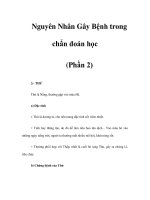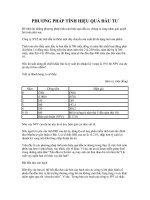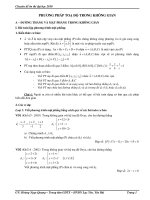Tài liệu PHƯƠNG PHÁP ĐỌC HIỂU TRONG THI ĐẠI HỌC ( PHẦN 2) doc
Bạn đang xem bản rút gọn của tài liệu. Xem và tải ngay bản đầy đủ của tài liệu tại đây (275.43 KB, 5 trang )
PHƯƠNG PHÁP ĐỌC HIỂU TRONG THI ĐẠI HỌC ( PHẦN 2)
Skill 4: IMPLIED DETAIL QUESTIONS
In this type of question, you will be asked to answer a multiple choice
question about a reading passage by drawing a conclusion from a specific
detail or details in the pas sage. Questions of this type contain the
words implied, inferred, likely, or probably to let you know that the
answer to the question is not directly stated. In this type of question, it is
important to understand that you do not have to "pull the answer out of
thin air." Instead, some information will be given in the passage, and you
will draw a conclusion from that information.
Example
The passage:
The number of rings in a tree can be used to determine how old a tree
really is. Each year a tree produces a ring that is composed of one light-
colored wide band and one dark-colored narrow band. The wider band is
produced during the spring and early summer when tree stem cells grow
rapidly and become larger. The narrower band is produced in fall and
early winter when cell growth is much slower and cells do not get very
large. No cells are produced during the harsh winter and summer months.
The question:
It is implied in the passage that if a tree has 100 wide bands and 100
narrow bands, then it is
A. a century old
B. two centuries old
C. fifty years old
D. two hundred years old
This question asks about the age of a tree with 100 wide
bands and 100 narrow bands. The passage does not tell the age of a tree
with 100 wide and narrow bands, but it does indicate that….wide
band and one.....narrow band are produced each year From this, you can
draw the conclusion that a tree with 100 wide and narrow bands is 100
years, or acentury, old. The best answer to this question is therefore
answer A..
The following chart outlines the key information that you should
remember about implied detail questions.
IMPLIED DETAIL QUESTIONS
It is implied in the passage that……
It can be inferred from the passage that..….
It is most likely that……
What probably happened.....?
The answers to these questions are generally found in order in the
passage.
1. Choose a key word in the question.
2. Scan the passage for the key word (or a related idea).
3. Carefully read the sentence that contains the key word.
4. Look for an answer that could be true, according to that sentence.
Skill 5: VOCABULARY IN CONTEXT QUESTIONS
You may be asked to determine the meaning of a difficult word or
expression that you do not know. In this case, the passage often gives you
a clear indication of what the word or expression means.
Example
The passage:
.......... ..........Professor Richmond's hobby is philately. The professor
has been quite interested in collecting stamps for a number of years
.......... ..........
The question:
The word "philately" in line 1 could best be replaced by
A. a philanthropic attitude
B. a common profession
C. stamp collecting
D. teaching classes
In this question, you are asked to choose an expression to
replace philately. You are not expected to know the meaning of the
word philately. Instead, you should understand from the context that if
the professor is interested in collecting stamps, then philately is most
likelystamp collecting. Answer C. is therefore the best answer to this
question.
The following chart outlines the key information that you should
remember about vocabulary questions:
VOCABULARY IN CONTEXT QUESTIONS
HOW TO IDENTIFY
THE QUESTION
What is the meaning of “X” in line Y?
The word “X” in line Y could best be replaced by…
WHERE TO FIND
THE ANSWER
Information to help you understand the meaning of a
vocabulary word can often be found in the context
surrounding the word.
HOW TO ANSWER
THE QUESTION
1. Find the word in the passage.
2. Read the sentence that contains the word
carefully.
3. Look for context clues to help you understand the
meaning.
4. Choose the answer that the context indicates.
Skill 6: "WHERE" QUESTIONS
There will be a multiple-choice question that asks where certain
information is found. The answer choices will list possible locations for
that information.
Example
The passage:
The words "capital" and "capitol" are confused in spelling and in
meaning by a lot of people who try to use them. Both their spellings and
their meanings are quite closely related. A "capital" is the location of the
center of government, while a "capitol" is the actual building where the
government officials meet. Thus, in the United States, for example, the
Capitol building is located in Washington, D.C., which is the capital city
of the United States.
The question:
Where in the passage does the author define the word "capital"?
A. Lines 1-2
B. Lines 3-4
C. Line 5
D. Line 6
To answer this question, you should skim for the word capital and
then look for its meaning A capital is the location of the center of
government, and this definition is given in the third line. Answer B. is
therefore the best answer to this question.
The following chart outlines the key information that you should
remember when you are trying to determine where in the passage
something is found:
QUESTION ABOUT WHERE IN THE PASSAGE
HOW TO
IDENTIFY THE
Where in the passage…….?
QUESTION
WHERE TO FIND
THE ANSWER
The answer can be in any of the lines listed
in the answer to the question.
HOW TO
ANSWER THE
QUESTION
1. Choose a key word or idea in the
question.
2. Skim the appropriate past(s) of the
passage looking for the key word or idea.
3. Choose the answer that contains the key
word or idea.









